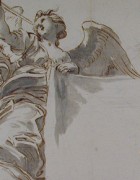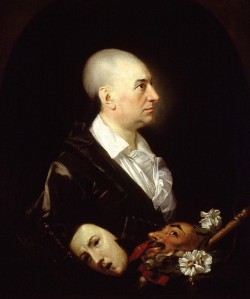Johan Zoffany (1733 – 1810)
David Garrick (c. 1763)
Ashmolean Museum, Oxford (read more)
This post is part of an ongoing online exhibition of images of fame and celebrity held by Oxford University’s Ashmolean Museum. If you’re interested in writing about an exhibit for us, email spotlightoncelebrity@gmail.com with your ideas.
David Garrick was the most famous actor in mid-eighteenth-century London, and the subject of possibly more portraits than any other individual. Unlike most of these portraits, this picture, from around 1763, doesn’t show him obviously performing on stage or even to a private audience; instead, it seems to capture him in a moment of private introspection. There is a story that Garrick had a regular habit of shaving in private every afternoon, and that the artist took advantage of this by hiding in his antechamber to spy on him and sketch the portrait secretly. Presented with the famous actor’s vulnerable, wigless scalp, informal clothes, and apparent unselfconsciousness, the viewer seems to be offered a privileged, intimate relationship with a man who, as the musical instruments, flowers and dramatic masks remind us, is a star performer normally seen in the disguise of a theatrical role.
Yet the artist, Johann Zoffany, can hardly have painted a likeness this detailed and finished while concealed in a wardrobe like a paparazzi photographer. Zoffany was, in any case, employed by Garrick, a brilliant self-publicist, to paint pictures which would promote his personal image, draw audiences to Drury Lane theatre, and could be profitably turned into prints. This portrait, then, created a carefully stage-managed illusion of intimacy, which immediately proliferated into multiple painted and printed copies in order to reach as big a public as possible. This one-way but intensely personal relationship between a famous individual and their fans – called a “parasocial” relationship by some theorists – is often seen as a key characteristic of a modern culture of celebrity. At the same time, it remains important for many famous actors and other stars to deny any deliberate self-publicising, and present themselves, like Garrick, as unconscious victims of the media’s invasions of their privacy.
Further reading
Shearer West, The Image of the Actor: Verbal and Visual Representation in the Age of Garrick and Kemble (New York: St Martin’s Press, 1991)
Heather McPherson, “Garrickomania: Art, Celebrity and the Imaging of Garrick.” An article for the Folger Shakespeare Library’s online exhibition David Garrick (1717-1779), A Theatrical Life (2005).

